The Microsoft Surface Book 2 (15-Inch) Review: Second Time's The Charm
by Brett Howse on December 21, 2017 8:00 AM EST- Posted in
- Laptops
- Microsoft
- Surface
- Pascal
- Surface Book
- Kaby Lake Refresh
Battery Life
The original Surface Book we tested was the Core i5 model, and it offered amazing battery life that the Core i7 model with a discrete GPU couldn’t quite match. With the Surface Book 2 15, the battery capacity has increased, although so has the display size and resolution, so it’ll be interesting to see how that impacts the results.
Our battery life tests include our older 2013 web browsing test, a newer 2016 web browsing test which is more demanding, and a movie playback test. All of our browsing is done with Edge, and movie playback with the built-in Films and TV software, with the display set at 200 nits of brightness.
2013 Light
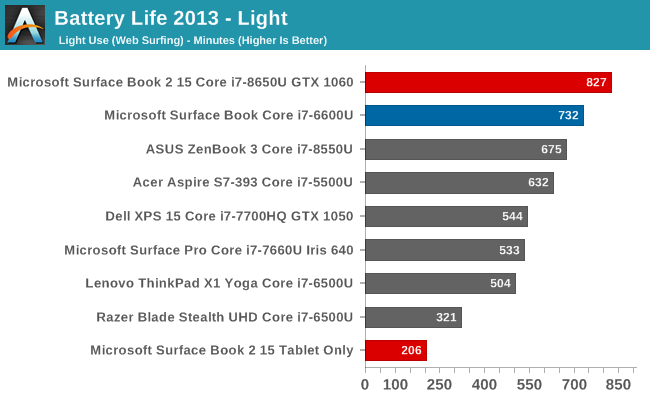
You feel kind of greedy when you feel like almost 14 hours of browsing isn’t enough, but it felt like the Surface Book 2 might really set a new record with the large 85 Wh of battery capacity. The new model handily outperforms the outgoing Surface Book Core i7 though, despite the larger display and higher resolution.
The tablet itself will still get several hours away from the base, which is more than enough time for the use case of the tablet, which is going to be for short sessions away from the base.
2016 Web
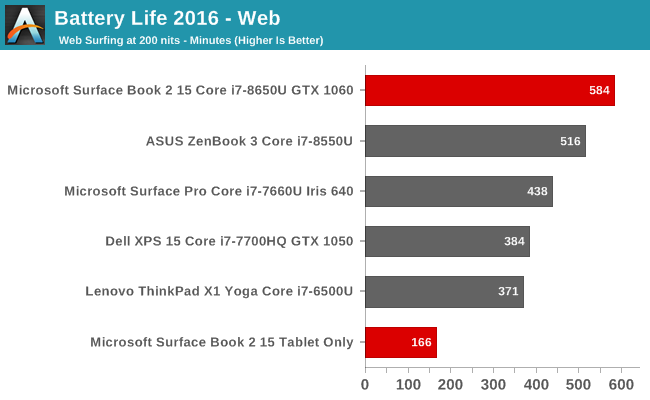
Our newer web test is more demanding of the CPU, and on devices like the Surface Book 2, where the CPU power usage is a significant factor in the overall power drain, the result is less battery life than our older, easier test. At almost ten hours of battery life though, the Surface Book 2 still offers a lot of time off the mains.
Normalized Results

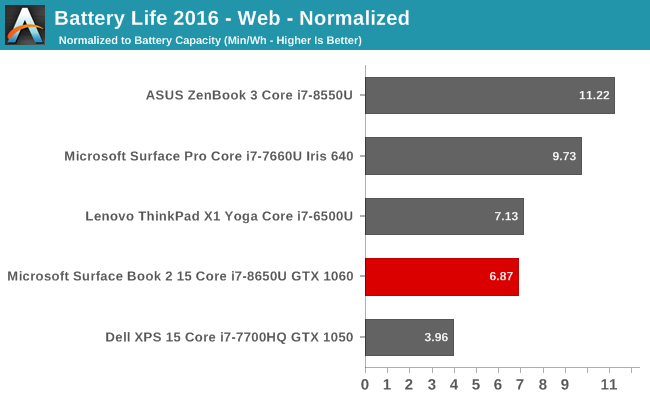
By removing the battery capacity from the equation, we can see the efficiency of each device. Here, the larger battery size is removed, and the Surface Book 2 ends up about midfield. The larger display and higher resolution of the display are a significant impact on the battery life.
To dig in to this a bit more, additional testing was done to see just how much power the display draws. At maximum brightness, and with the system at idle, the display draws 7.65 W of power, while the rest of the system only consumes 1.43 W of power. On our 200 nit display brightness setting, that power requirement of the display drops to 4.1 W, which is still over double what the rest of the system is using at idle. The display is a significant factor, as expected.
Movie Playback
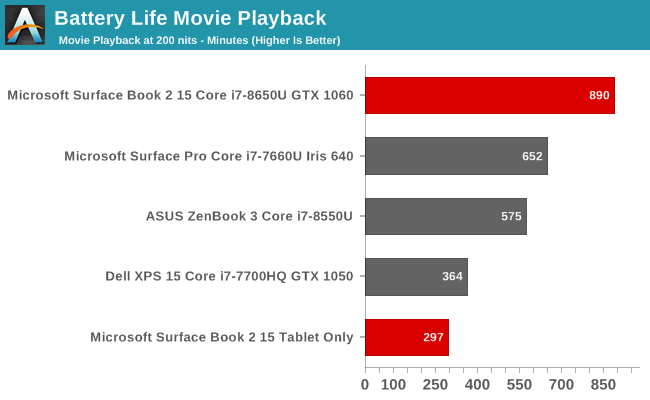

When playing back a movie, the CPU can offload the task to fixed function hardware, so the overall power usage goes down even further than normal. The Surface Book 2 offers tremendous battery life at this task, coming in at close to 15 hours.
This would let you play The Avengers over six times on a single charge. That should be enough for almost any scenario.
With just the tablet, the battery life is still almost five hours of movie playback, which is certainly usable, although I doubt most people would use just the tablet to watch movies due to the size of it.
Charge Time
Despite the larger battery, the 100-Watt AC Adapter charges the battery quite quickly, and both batteries are full in under three hours.
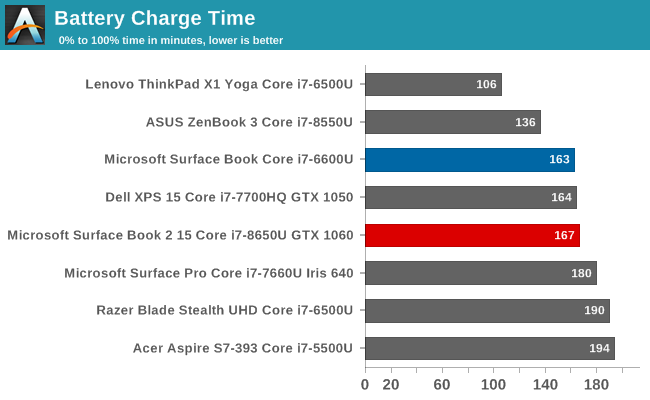
Both batteries charge at the same time, and are almost in lock-step with each other in terms of charge, despite the difference in capacity.
For those interested, the bottom of the tablet features the same Surface Connect port, so you can charge the tablet away from the base if necessary, although most of the time it would be charged when docked.


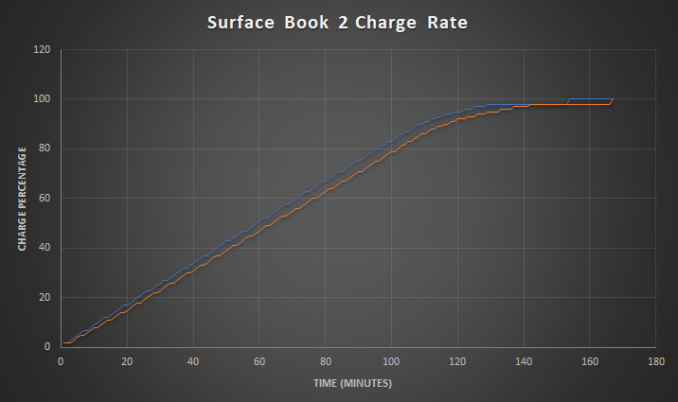








120 Comments
View All Comments
manurk112 - Thursday, December 21, 2017 - link
Hey Brett, did you notice any significant coil whine? I bought the 13 inch, and on best performance mode you can hear it distinctly. Most of other reviews mentionned it, but you didn't. As for the lack of Thunderbolt, Is it not linked to limitations of the surface connector?Brett Howse - Thursday, December 21, 2017 - link
There's no coil whine at all on the unit I have but it's not the 13 so maybe it's specific to that one.Surface Connect doesn't impact Thunderbolt 3 since it's the USB-C port next to it that would need the ICs for the extra bandwidth.
manurk112 - Friday, December 22, 2017 - link
Be damned.... probably means that I should better return the unit I have and wait that they have sorted the issue out on latter batches. Thanks for the heads up, and the test, which is great as usualquiksilvr - Thursday, December 21, 2017 - link
Why don't you guys show the display analysis results of Macbook Pro's alongside the PCs? I'm curious as to how they stack up.Brett Howse - Thursday, December 21, 2017 - link
We haven't tested one recently but here's a comparison with the 2014 rMBPhttps://www.anandtech.com/bench/product/2056?vs=13...
StanFL - Thursday, December 21, 2017 - link
I own one (13.5" with i7 and GTX 1050) and absolutely love it. Used to have a Surface Pro 3 and this is better in so many different ways I wouldn't really know where to start.Notmyusualid - Friday, December 22, 2017 - link
Very nice.Can I have this in a 20" screen and dual GPUs please? I don't care much for the tablet function, but I do like high-res screens, and well constructed devices...
eddman - Friday, December 22, 2017 - link
Was cinebench run once or in a loop? I want to know the sustained frequency after a few minutes.Brett Howse - Friday, December 22, 2017 - link
My script runs it 12 times total.Average CPU frequency after 20 minutes of Handbrake was 2538.5 MHz if that helps.
eddman - Saturday, December 23, 2017 - link
Thanks; so that 629 score was the highest recorded or the last reading?